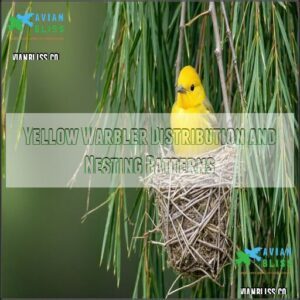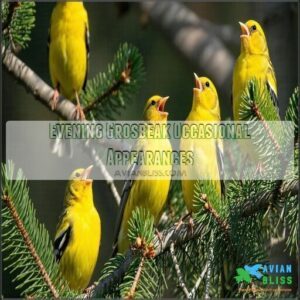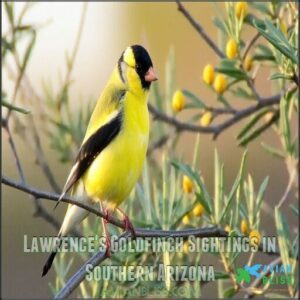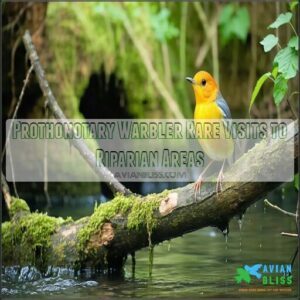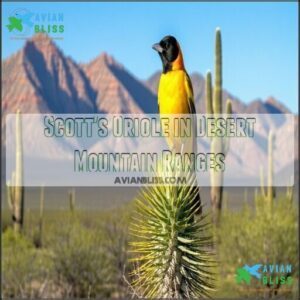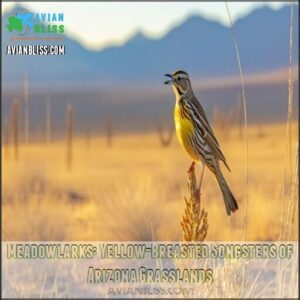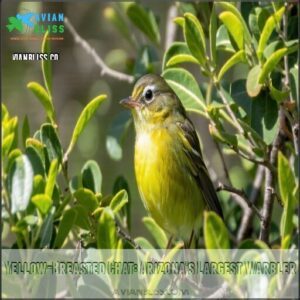This site is supported by our readers. We may earn a commission, at no cost to you, if you purchase through links.
 Arizona is a goldmine for spotting yellow birds! You’ll see American Goldfinches flitting around gardens, while Lesser Goldfinches add bright pops in desert shrubs.
Arizona is a goldmine for spotting yellow birds! You’ll see American Goldfinches flitting around gardens, while Lesser Goldfinches add bright pops in desert shrubs.
Yellow Warblers and Wilson’s Warblers brighten riparian zones during migration. Don’t miss the striking Yellow-Breasted Chat, often hiding in dense thickets.
Scott’s Oriole and Yellow-Headed Blackbirds prefer grasslands and marshes, where their vivid plumage stands out. Even high desert areas host Verdins, tiny yellow-headed specialists.
To attract these beauties to your yard, offer native plants, water features, and seed-filled feeders. Arizona’s variety of yellow birds promises unforgettable sights—and maybe a new favorite feathered friend!
Table Of Contents
- Key Takeaways
- Common Yellow Birds in Arizona’s Desert Regions
- Rare Yellow Birds Spotted in Arizona
- Yellow-Rumped Warblers: Arizona’s Winter Visitors
- Arizona’s Yellow Hummingbirds: Tiny Flashes of Gold
- Yellow-Headed Blackbirds in Arizona Wetlands
- Meadowlarks: Yellow-Breasted Songsters of Arizona Grasslands
- Yellow-Breasted Chat: Arizona’s Largest Warbler
- Verdins: Tiny Yellow-Headed Desert Specialists
- Yellow Birds in Arizona’s Sky Islands
- Attracting Yellow Birds to Arizona Backyards
- Frequently Asked Questions (FAQs)
- What is a yellow bird in Arizona?
- What is the smallest yellow bird in Arizona?
- What are the most common backyard birds in Arizona?
- Are blue-winged warblers rare in Arizona?
- What are the little yellow birds in Arizona?
- What is the most common yellow bird?
- What does a yellow warbler look like?
- What is the yellow bird that looks like a goldfinch?
- What is the difference between a yellow finch and a yellow warbler?
- What is the yellow bird in Arizona?
- Conclusion
Key Takeaways
- You’ll spot vibrant yellow birds like the American Goldfinch, Yellow Warbler, and Lesser Goldfinch thriving in Arizona’s varied habitats, from deserts to riparian zones.
- Attract these birds by offering native plants, water features, and seed-filled feeders like nyjer and sunflower seeds tailored to their diets.
- Migration patterns make spring and fall the best times to spot species like Wilson’s Warblers, while residents like Verdins adapt year-round to the desert’s harsh conditions.
- Habitat loss threatens many species, but conservation efforts, like preserving wetlands and riparian zones, can help maintain Arizona’s rich bird diversity.
Common Yellow Birds in Arizona’s Desert Regions
You’ll spot several yellow birds brightening Arizona’s desert regions, including the American Goldfinch, Lesser Goldfinch, Yellow Warbler and Wilson’s Warbler.
Bright yellow wings and cheerful calls bring life to Arizona’s deserts, with goldfinches and warblers stealing the show.
These colorful species have adapted to the harsh desert climate, finding homes in riparian areas, desert edges and wherever native vegetation provides food and shelter, which is a key factor for their survival.
American Goldfinch Habitat and Behavior
While some birds migrate south for winter, the American Goldfinch can be spotted year-round in Arizona’s varied landscapes.
These small, social birds thrive in open woodlands, meadows, and gardens where seed-producing plants are plentiful. During breeding season (late summer), males display brilliant yellow plumage with black caps, while females maintain more subdued olive-yellow colors.
When observing their behavior in Arizona, look for:
- Undulating flight patterns that resemble waves in the air
- Group foraging habits as they extract seeds from thistles and sunflowers
- Winter roosting in large flocks for protection and warmth
- Interesting molting patterns that transform males from bright yellow to olive-brown
Their diet consists almost entirely of seeds, making them strict vegetarians among Arizona’s bird species. They often require specific seed blends for ideal health. You’ll often spot them hanging acrobatically from seed heads while feeding, showcasing their unique ability to thrive on a diet of seeds from various plants, including thistles and sunflowers.
Lesser Goldfinch Identification and Feeding Habits
While American Goldfinches bring seasonal color, the Lesser Goldfinch stays year-round in southern Arizona.
You’ll identify these tiny yellow birds by their black caps (males) and distinct plumage variations between populations.
Their specialized beaks crack open their favorite seeds—nyjer, thistle, and sunflower—with impressive efficiency.
Watch their unique foraging behavior as they hang upside-down from seed heads, and listen for their sweet, canary-like vocalizations that vary across regions.
These social birds gather in small flocks, bringing cheerful activity to desert feeders throughout Arizona, and they thrive on specific seed blends readily available for purchase.
Yellow Warbler Distribution and Nesting Patterns
While lesser goldfinches brighten Arizona’s landscape year-round, Yellow Warblers bring their own splash of sunshine from March through October.
You’ll spot these vibrant birds in 14% of summer checklists across Arizona’s riparian corridors.
Yellow Warblers construct impressive nests where water meets land. Their habitat preferences revolve around:
- Willow thickets along streams and wetlands
- Cottonwood groves with dense understory
- Mesquite bosques with nearby water sources
- Streamside vegetation with abundant insects.
Their cup-shaped nests showcase remarkable craftsmanship, woven from plant fibers, grasses, and spider silk. You can find Yellow Warbler nest products online.
When Brown-headed Cowbirds attempt brood parasitism, Yellow Warblers often build new nests directly on top of parasitized ones—a clever adaptation that helps guarantee breeding success in Arizona’s diverse bird habitats.
Wilson’s Warbler Migration and Breeding Habits
You’ll frequently spot Wilson’s Warblers during their migration through Arizona, especially in spring (March-May) and fall (August-October).
Their bright yellow birds with distinctive black caps (males) establish breeding territories in moist woodland edges.
Their nesting ecology involves ground-level nests hidden in dense shrubs, providing protection from predators.
Diet variation occurs seasonally, with insects making up most of their menu, and you can listen for their rapid "chit-chit-chit" vocalizations when you’re near streams or thickets.
Though some stay for winter in southern Arizona (appearing on 0.4% of winter checklists), most continue their bird migration to Mexico and Central America.
Rare Yellow Birds Spotted in Arizona
You’ll find several rare yellow birds in Arizona that appear only during specific migration periods or as occasional visitors.
The Evening Grosbeak, Lawrence’s Goldfinch, Prothonotary Warbler, and Scott’s Oriole represent some of the most exciting yellow bird sightings you can add to your Arizona birding checklist, including the Evening Grosbeak.
Evening Grosbeak Occasional Appearances
A golden flash among the pines signals an Evening Grosbeak’s treasured visit to Arizona.
These irruptive migrants don’t follow predictable migration patterns, making each sighting special for arizona bird species enthusiasts.
- Watch for bright yellow, black and white plumage at higher elevation forest edges
- Fill platform feeders with sunflower seeds to attract these rare yellow birds
- Listen for distinctive "kleer" calls that announce their presence
- Look for large flocks during population fluctuations in winter months
- Check historical sightings in mountain habitats where they occasionally appear
Keep binoculars ready—their unpredictable arizona bird habitats visits make each encounter a gift!
Lawrence’s Goldfinch Sightings in Southern Arizona
While Evening Grosbeaks visit occasionally, Lawrence’s Goldfinch remains one of Arizona’s most coveted rarities.
These nomadic finches appear unpredictably in southern Arizona, with historical nesting records dating back to 1952.
Males display distinctive black faces and yellow wing patches, making identification straightforward when spotted in oak savanna or chaparral habitats.
Winter sightings occur most frequently, though breeding has been documented after wet springs.
Recent reports from Verde Valley and Prescott have excited local birders.
Their unpredictable movements make each sighting special – you’ll need patience and keen eyes to spot these small yellow birds.
A flock was recently observed during the Prescott Christmas Bird Count.
Prothonotary Warbler Rare Visits to Riparian Areas
While Lawrence’s Goldfinch brightens southern Arizona, the Prothonotary Warbler appears as an Eastern vagrant in Arizona’s riparian areas.
This bright yellow bird visits annually but remains rare in Arizona wetlands. You can spot its orange-yellow head and blue-gray wings along streams at places like Gilbert Water Ranch.
The conservation status of these "golden lanterns" is least concern globally, but their riparian habitat faces challenges. Identification challenges come from their brief visits.
Watch for these signs of Prothonotary Warblers in Arizona:
- Completely yellow-orange heads with beady black eyes
- Slow, deliberate movements near water
- Preference for dead trees with cavities
- Annual appearances during spring migration
Scott’s Oriole in Desert Mountain Ranges
The striking Scott’s Oriole makes its home in Arizona’s desert mountain ranges, where you’ll find these bright yellow birds with distinctive black heads and wings.
Perfectly adapted to harsh conditions, these desert birds arizona thrive among yucca plants and Joshua trees.
Their unique desert adaptation allows them to survive where other yellow birds arizona cannot.
Scott’s Oriole habitat typically includes arid slopes between 3,000-6,000 feet elevation.
During breeding behavior, males sing clear, flute-like songs to attract mates.
Though not endangered, their mountain distribution is closely tied to healthy yucca populations, and their conservation status remains stable, but these arizona wildlife birds face challenges from habitat loss in some regions.
Yellow-Rumped Warblers: Arizona’s Winter Visitors
You’ll spot Yellow-rumped Warblers throughout Arizona from September to May, appearing on 33% of winter bird checklists with their distinctive yellow rump patches and white wing bars.
These active winter visitors catch insects in midair and will visit your feeders for sunflower seeds, suet, and peanut butter during the colder months.
Identification Features of Audubon’s Subspecies
Audubon’s Yellow-rumped Warblers are easy to identify by their bright yellow throat and rump patch. You’ll notice they lack the white eyebrow of other subspecies.
Their blue-gray backs with dark streaks and white wing bars stand out against Arizona’s winter landscapes. Listen for their rising "chit" call variations.
The males display brighter yellow plumage with black chest patches, while females appear more muted. When identifying yellow birds in Arizona, look for the distinctive double-half-moon eye ring common to this subspecies.
Many backyard birds are easily identified by plumage and size.
Preferred Habitats During Arizona Winters
Yellow-rumped Warblers select specific winter habitats across Arizona to survive the cooler months.
These adaptable birds choose locations based on food availability and shelter from harsh weather.
Look for them in these prime winter locations:
- Desert riparian areas where water source availability supports insects even in winter
- Urban winter habitats like parks and gardens with bird feeders
- Juniper woodlands offering both roosting site selection and winter food sources
Unlike other arizona birds, Yellow-rumps can digest waxy berries, allowing them to thrive in habitats where other yellow birds can’t survive cold weather adaptations.
Foraging Behavior and Diet Adaptations
While wintering in Arizona, Yellow-rumped Warblers show remarkable feeding flexibility.
You’ll notice these adaptable birds switching between hunting flying insects and plucking berries from shrubs.
Their winter diets include waxy berries that other birds can’t digest, giving them a survival edge when food is scarce.
This habitat foraging versatility allows them to thrive when other yellow birds in Arizona struggle.
Watch for their distinctive foraging style as they flit between ground-level seed gathering and mid-air insect catching.
Spring Migration Patterns From Arizona
Each spring, thousands of Yellow-rumped Warblers begin their journey north from Arizona between March and May, driven by powerful migration triggers including changing daylight hours and rising temperatures.
During peak migration, you’ll notice these birds traveling in waves that follow predictable bird migration routes. The key factors influencing their journey include:
- Males typically depart first, racing to claim prime breeding territories
- Most birds follow major river corridors like the Colorado and Salt Rivers
- Weather impacts can delay departures by up to two weeks
- Stopover habitats in northern Arizona serve as essential refueling stations
Conservation efforts focus on protecting these critical stopover points, which yellow birds depend on during their exhausting migratory journey. Watch for them gathering in cottonwoods before their final push northward, highlighting the importance of preserving these areas for the warblers’ survival.
Arizona’s Yellow Hummingbirds: Tiny Flashes of Gold
You’ll spot Arizona’s yellow hummingbirds darting between desert flowers like tiny gold meteors during your birding adventures.
These small but mighty birds include the year-round Anna’s, the desert-loving Costa’s, the iridescent Broad-billed, and the fiercely territorial Rufous species that bring a flash of color to Arizona’s landscape.
Anna’s Hummingbird Year-round Presence
Despite their name, Anna’s Hummingbirds display subtle yellow accents amid their predominant emerald and rose-colored plumage throughout Arizona’s varied landscapes year-round.
These tiny dynamos have adapted remarkably well to urban environments, unlike many other Arizona birds.
Their Annas Diet consists mainly of nectar and small insects, making them easy to attract with:
- Red tubular flowers like salvias and penstemons
- Clean sugar-water feeders (four parts water, one part sugar)
- Native desert plants that bloom in different seasons
- Small water features where they can bathe
Listen for their distinctive metallic "chip" calls during bird watching Arizona trips. Males perform spectacular dive displays, climbing 130 feet before plummeting toward females with a loud chirp.
Their Urban Adaptations include nesting on human structures and visiting feeders even in winter.
Costa’s Hummingbird in Sonoran Desert Gardens
The striking Costa’s Hummingbird brings vibrant purple throat patches throughout Sonoran Desert gardens, preferring the hottest, driest habitats in Arizona.
Males display remarkable Desert Adaptation with their brilliant purple gorgets that flash in sunlight.
These tiny birds rely on desert Nectar Sources from ocotillo, saguaro, and penstemon blooms, playing a vital Pollination Role for native plants.
You can attract these jewel-like visitors with smart Garden Design that includes shallow water features and year-round sugar-water feeders.
Their Conservation Status remains stable, but they depend on preserved desert landscapes and bird habitats.
Look for their distinctive cup-shaped nests tucked carefully in thorny desert shrubs.
Broad-billed Hummingbird’s Iridescent Plumage
While Costa’s Hummingbird charms garden visitors, the Broad-billed Hummingbird takes the spotlight with truly remarkable plumage iridescence. This tiny Arizona bird doesn’t just have yellow highlights—it’s a walking rainbow.
The secret behind its dazzling colors isn’t pigment but feather structure that creates light refraction. As sunlight hits these specialized feathers from different angles, the bird seems to change colors before your eyes.
- Males display a brilliant blue throat and emerald-green body that shifts in intensity with movement
- Females show more subtle green tones with grayish underparts
- Both sexes feature the distinctive broad red-orange bill with black tip
You’ll spot these jewel-like birds visiting nectar feeders and native flowering plants throughout southern Arizona. Their evolutionary significance lies in their ability to attract mates through this spectacular coloration purpose.
Rufous Hummingbird’s Aggressive Territorial Behavior
While Broad-billed Hummingbirds dazzle with color, the Rufous Hummingbird dominates Arizona’s landscape through pure attitude.
Don’t be fooled by their tiny size—these copper-colored dynamos are the bullies of the bird world.
You’ll witness their Territory Defense as they chase birds twice their size from feeders.
During Migration Impact periods, their Aggression Signals include dive-bombing competitors and emitting sharp, warning chirps to protect valuable nectar resources.
Yellow-Headed Blackbirds in Arizona Wetlands
You’ll spot Yellow-headed Blackbirds in Arizona’s wetlands year-round, with peak sightings during September and October when they appear in 3% of birding checklists.
Their bright yellow heads contrast sharply with glossy black bodies, making them one of the most striking wetland species you can find during your birdwatching trips.
Breeding Colonies in Marsh Habitats
Across Arizona’s marshes, Yellow-Headed Blackbirds create bustling colonies in cattail-rich wetlands.
You’ll find these striking yellow birds establishing territorial breeding grounds in deeper water areas. Males claim prime spots first, arriving 2-3 weeks before females to secure the best marsh nesting locations.
- Colony dynamics: Males attract harems of up to eight females within their territories
- Predation impacts: Deeper water locations protect nests from many threats
- Habitat loss: Arizona’s wetlands face conservation challenges
- Strategic selection: Females choose sites based on previous breeding success
Distinctive Vocalizations and Displays
When walking near Arizona wetlands, you’ll hear Yellow-headed Blackbirds’ unmistakable rusty-gate vocalizations cutting through the air.
These arizona birds produce complex song dialects that vary between populations.
Males perform elaborate courtship rituals, spreading their wings while belting out harsh calls to attract mates.
Their bird behavior includes impressive mimicry skills of other species and distinctive alarm calls that alert the entire colony to danger.
During breeding season, their displays become more intense, with males bobbing their bright yellow heads while producing a variety of bird songs ranging from deep croaks to high-pitched whistles, showcasing their elaborate courtship rituals and complex song dialects.
Foraging Strategies in Agricultural Areas
Beyond their striking calls and displays, Yellow-headed Blackbirds show remarkable foraging skills in Arizona’s agricultural landscapes.
These bright-headed birds have adapted well to farming areas, where they find both food and shelter. Their feeding habits benefit farmers through natural crop pest control while supporting their own survival needs.
In agricultural settings, you’ll observe them:
- Methodically hunting insects among crop rows, helping reduce pest populations
- Gathering fallen seeds after harvest, aiding in seed predation of unwanted plants
- Foraging along irrigation ditches where water attracts concentrated food sources
Despite pesticide exposure and habitat fragmentation from farming, these yellow birds maintain stable populations in agricultural zones. Their ability to adjust their diets from insects to grains helps them thrive where farmland meets wetlands.
Population Trends and Conservation Efforts
Yellow-headed Blackbirds in Arizona face significant habitat loss due to climate change and development.
Conservation programs focus on protecting their wetland breeding grounds, with population monitoring showing concerning declines in recent decades.
You can help these striking yellow birds through citizen science projects that track their numbers across Arizona.
Public awareness has grown as bird conservation efforts highlight their importance to local ecosystems.
By supporting wetland preservation, you’re ensuring future generations can still marvel at these distinctive Arizona birds with their vibrant golden heads.
Meadowlarks: Yellow-Breasted Songsters of Arizona Grasslands
You’ll find both Eastern and Western Meadowlarks in Arizona’s grasslands, where their bright yellow chests stand out against brown-speckled backs.
Their clear, flute-like songs fill the air year-round, with Western Meadowlarks being more common in winter months across the southern regions, and their presence is notable for the bright yellow chests.
Eastern Meadowlark Vs. Western Meadowlark Identification
Telling Eastern and Western Meadowlarks apart requires a keen eye when birdwatching in Arizona. Both sport bright yellow breasts with distinctive black V-shaped markings, but several key differences help with identification.
- Western Meadowlarks have yellow malar regions, while Easterns display white ones
- The Eastern’s head stripes appear darker than the Western’s paler pattern
- You’ll notice more white in the Eastern’s tail during flight
Song variations offer another clue – Western Meadowlarks produce complex, flute-like melodies, while Eastern songs sound simpler and less musical. Both species create hybridization risks where their range boundaries overlap throughout Arizona’s grasslands. With practice, you’ll confidently identify these yellow-breasted songsters.
Habitat Preferences in Arizona’s Open Country
Unlike their similar appearances, Western and Eastern Meadowlarks have distinct habitat preferences across Arizona’s open country.
These yellow-breasted birds have adapted perfectly to our diverse landscapes, with unique desert adaptations that help them thrive.
You’ll find meadowlarks in:
- Native grasslands with abundant tall grasses for nesting and roosting behavior
- Agricultural fields where their open country diet includes insects and seeds
- Desert scrublands near sparse water sources
- High-elevation meadows throughout Arizona’s varied terrain, which provide them with the necessary conditions for survival in open country.
Nesting Behavior and Breeding Season
Meadowlarks begin their nesting activities in Arizona’s grasslands during March through July.
Their nest construction is a marvel of natural engineering—females craft dome-shaped nests with side entrances using grasses woven into ground vegetation for protection.
Each clutch typically contains 3-7 speckled eggs that parents incubate for 13-15 days.
After hatching, fledgling care continues for 10-12 days until young birds can fly.
You’ll often spot male meadowlarks perched on fence posts or shrubs, announcing their breeding territories with distinctive, flute-like songs across Arizona’s open country.
Conservation Status in Arizona
Both Eastern and Western meadowlarks face alarming declines across Arizona’s grasslands.
You’ll notice their populations have dropped by over 75% since the 1960s, with Western meadowlarks appearing in just 5% of winter checklists.
Habitat loss from agricultural expansion remains their greatest threat.
- Join citizen science projects to help track arizona birds in protected areas
Climate change and pesticide impact further endanger these yellow-breasted songsters.
Arizona bird conservation efforts focus on preserving native grasslands and sustainable farming practices.
You can support yellow birds by participating in local conservation initiatives—their morning songs are worth saving.
Yellow-Breasted Chat: Arizona’s Largest Warbler
You’ll spot the Yellow-breasted Chat in Arizona’s dense riparian thickets where it stands out as the largest warbler in the state at 7-8 inches long.
During summer months, you can identify this striking bird by its bright yellow breast, white eyebrows, and unusual varied calls that include whistles, cackles, and grunts, which are key to recognizing the Yellow-breasted Chat.
Unique Vocalizations and Courtship Displays
The Yellow-breasted Chat stands out among Arizona birds with its remarkable vocal performances.
You’ll hear an impressive mix of whistles, cackles, and even mimicry in their territorial songs.
During breeding season, males put on elaborate display rituals, flying in unusual patterns while singing complex song variations.
These vocal gymnastics play a vital role in mate selection.
Next time you’re near riparian areas, listen for their distinctive bird songs and calls.
Preferred Habitats in Riparian Thickets
Arizona’s narrow stream borders create perfect homes for Yellow-Breasted Chats.
These birds need about 1-1.2 hectares of early successional riparian habitat with well-developed shrub layers.
You’ll spot them in dense thickets up to 300 meters along desert washes, but rarely in upland areas.
Habitat restoration projects are essential for their survival.
- Dense vegetation offers safety from hawks and other threats
- Shrub layers create ideal thicket microclimates
- Water access supports rich riparian bird diets
- Habitat structure matters more than plant age for nesting site selection
Conservation challenges arise as these critical habitats shrink.
Breeding Behavior and Nest Construction
Moving from their favored thicket habitats, the fascinating nesting behavior of Yellow-breasted Chats begins with careful nest site selection.
You’ll find these vibrant yellow birds constructing cup-shaped nests using twigs, grasses, and leaves about 2-8 feet above ground in dense vegetation.
Their clutch size typically ranges from 3-5 eggs, with an incubation period lasting 11-12 days.
Both parents share fledgling care duties, bringing food to the nest until young birds leave after 8-11 days.
In Arizona, breeding typically occurs from May through July, when riparian areas buzz with their distinctive nesting activities and vocal displays.
Migration Patterns Through Arizona
The Yellow-Breasted Chat’s migration patterns through Arizona follow predictable seasonal rhythms.
You’ll notice these vibrant birds moving along specific flyway routes twice yearly.
- Climate impacts trigger spring northward journeys in April-May
- Stopover habitats along rivers provide essential rest areas
- Fall migration begins in August with peak movement in September
- Seasonal abundance varies by region, with higher concentrations in riparian corridors
Arizona’s position along major bird migration tracking routes makes it ideal for observing both Yellow Warblers and chats during their impressive journeys.
Verdins: Tiny Yellow-Headed Desert Specialists
You’ll spot these tiny desert birds by their bright yellow heads and gray bodies as they build their unique globe-shaped nests in mesquite and palo verde trees.
Verdins stay in Arizona year-round and eat insects and nectar, making them perfect subjects for your desert birdwatching adventure.
Adaptations to Arizona’s Arid Environments
Verdins show remarkable adaptations to Arizona’s arid environments. These tiny yellow-headed birds survive where others can’t through smart survival tactics.
Verdins thrive in Arizona’s harsh desert by conserving water, foraging smartly, and building specially designed nests for extreme desert conditions.
You’ll notice their incredible water conservation as they extract moisture from insects and desert fruits rather than drinking directly. Their desert diet consists primarily of these insects and occasional nectar.
Heat tolerance is their superpower in Arizona’s harsh climate:
- They rest during peak heat hours in shaded microhabitats
- Their small bodies require less energy to cool
- They maintain efficient metabolism that wastes little water
Watch for their bright yellow heads bobbing through desert landscapes—nature’s perfect example of adaptability.
Unique Nest-building Techniques
Skilled craftsmanship defines these tiny desert architects. You’ll marvel at their spherical, grapefruit-sized nests with entrances strategically positioned to manage desert temperatures.
These birds thrive in areas with thorny native vegetation, which provides shelter and nesting sites.
| Nest Feature | Function |
|---|---|
| Thick insulation | Reduces energy needs by 50% |
| Thorny twig exterior | Provides protection |
| Soft interior lining | Offers comfort for young |
| East-facing entrance | Manages heat and wind |
Males build outer shells while females add lining—true cooperative nesting among Arizona birds, showcasing their skilled craftsmanship and thorny native vegetation use for shelter and nesting sites.
Foraging Behavior in Desert Vegetation
While observing Arizona’s yellow birds, you’ll notice their smart foraging in desert vegetation.
Verdins have perfected their desert survival tactics through specialized feeding behaviors.
Watch for these fascinating patterns:
- Extracting insects from cactus joints and tree bark with their sharp bills
- Collecting seeds from desert plants, especially during dry months
- Sipping nectar from flowering cacti and ocotillo for both nutrition and hydration
Their efficient feeding strategies help these tiny yellow-headed specialists thrive where water is scarce.
Year-round Residency in The Sonoran Desert
Unlike most yellow birds in Arizona that migrate, the tiny Verdin stays put year-round in the Sonoran Desert.
Their desert adaptations include building special winter nests that cut energy needs by 50% during cold nights.
You’ll find these hardy birds facing their nest entrances into prevailing winds—a smart response to heat.
Despite water scarcity and climate change threats, their continuous breeding success makes them true desert survivors compared to the migratory Yellow Warbler.
Yellow Birds in Arizona’s Sky Islands
You’ll spot colorful yellow birds like Western Tanagers and Grace’s Warblers in Arizona’s Sky Islands, where isolated mountain forests create unique bird habitats.
These high-elevation "islands" of forest surrounded by desert offer perfect viewing spots for yellow species that can’t be seen in Arizona’s lower desert regions, making the Sky Islands a key location for spotting Western Tanagers.
Western Tanager in Mountain Forests
While tiny Verdins thrive in desert landscapes, Western Tanagers paint Arizona’s mountain forests with vibrant splashes of color.
You’ll find these striking yellow birds in coniferous habitats above 4,000 feet elevation.
Their Arizona migration patterns follow a predictable schedule:
- Arrive April-May from Central America
- Establish breeding season territories quickly
- Build nests in tall pines during summer months
- Feed mainly on forest insects plus some berries
- Depart by October for winter homes, which is a predictable schedule that helps in understanding their migration patterns and breeding season.
Townsend’s Warbler in High-elevation Habitats
While the Western Tanager brightens mountain forests with its flame-colored head, Townsend’s Warblers bring their own magic to Arizona’s high-elevation habitats.
These striking yellow and black warblers thrive in coniferous forests above 5,000 feet. You’ll spot them hunting insects among pine and spruce trees during spring and fall migrations.
- Forest Dependence: They rely on mature coniferous forests for nesting and feeding
- High-Elevation Diet: They eat mainly insects, spiders, and occasionally berries
- Conservation Status: Facing challenges from climate change and habitat loss
Hepatic Tanager in Pine-oak Woodlands
Female Hepatic Tanagers in Arizona’s pine-oak woodlands display yellowish plumage, unlike their red male counterparts.
You’ll find these native birds at 5,000-8,000 ft elevations, where they build nests of grass and moss on horizontal branches.
Their diet consists mainly of insects, with fruits added in late summer.
For identification, look high in tree crowns where they forage by hopping upward, a key habitat requiring conservation against threats like deforestation.
Grace’s Warbler in Coniferous Forests
Among the pines of Arizona’s sky islands, you’ll spot Grace’s Warbler, a small yellow-throated bird with perfect habitat specificity for coniferous forests.
This gray-backed warbler with distinctive black streaks feeds exclusively on insects hidden in pine needle clusters.
- Nests on outer pine branches, typically 6-18 feet high with specialized nesting ecology
- Diet composition consists entirely of insects and spiders gleaned from bark and foliage
- Conservation status shows concerning decline due to loss of mature pine habitats
- Often found with sympatric species like Yellow-rumped Warbler in mountain forests
Look up to the treetops – their trilling song gives away their presence before arizona bird identification is possible.
Grace’s Warblers face threats from habitat loss in their wintering grounds, which is a significant concern for their conservation status and overall well-being in coniferous forests.
Attracting Yellow Birds to Arizona Backyards
You can attract yellow birds to your Arizona backyard by providing the right mix of food, water, and shelter.
Adding native plants and bird feeders with seeds they love will quickly turn your yard into a vibrant bird haven.
Native Plants That Attract Yellow Birds
Bring Arizona’s stunning yellow birds to your backyard with native plants like sunflowers, thistles, desert marigolds, canyon hackberries, and wolfberries.
These Desert Blooms also beautify your space and create perfect Backyard Habitats. From natural seeds to reliable shelter, they meet the bird habitat and bird diet needs of species like Lesser Goldfinches and Yellow Warblers.
Desert Marigolds, for instance, light up your yard while supporting pollinators essential to ecosystems.
Grow a Native Seed Mix or explore Wildflower Gardening for colorful companions that attract arizona birds effortlessly!
Creating Water Features for Desert Birds
When you’re trying to attract Arizona’s yellow birds, like the Yellow-rumped Warbler, adding water to your backyard makes all the difference. Choose water feature types like shallow bird baths—they’re perfect for desert birds.
Bird bath placement matters too! Put them near bushes or desert plant pairings for much-needed shade. For a revitalizing touch, pick fountains with gentle trickles.
Want something simple but effective? Try a water drip system to keep birds coming back. Bigger plans? A small pond with sloping edges lets birds drink safely.
Keep water clean; dirty water deters birds and attracts predators. Regular maintenance and cleaning guarantees safety and keeps your features inviting.
With a little effort, you’ll create a relaxing haven for Arizona birds and enjoy birdwatching up close!
Bird Feeder Types and Seed Preferences
The right bird feeders and seeds can transform your Arizona backyard into a haven for yellow birds.
Tube and hopper feeders work wonders for goldfinches, while nyjer thistle and sunflower seeds meet their specific diets. Place feeders near shrubs for bird safety and out of predators’ line of sight—squirrel deterrents might help too!
Clean feeders often; once a week is ideal to maintain hygiene and prevent disease.
For attracting hummingbirds, consider colorful nectar feeders designed for easy access.
- Ideal Seeds: Try mixing sunflower hearts and nyjer thistle for variety.
- Strategic Placement: Position feeders in shaded, quiet spots for visiting birds’ comfort.
With a little effort, you’ll soon see your space buzzing with vibrant yellow birds, keeping nature close at heart!
Seasonal Considerations for Yellow Bird Attraction
Seasonal planning is essential if you want to attract vibrant yellow birds to your Arizona backyard year-round.
Adjust to migration patterns and habitat changes by timing feeder setups to match their spring and fall movements. In summer, focus on nesting habitats with native plants that offer food and shelter. During winter, prioritize feeding stations stocked with thistle and sunflower seeds, which birds like yellow warblers love.
Provide water sources, especially in shaded areas, to combat the dry Arizona climate. Add nesting materials like twigs during breeding months. Small efforts keep birds returning.
| Season | Focus | Essentials |
|---|---|---|
| Spring | Migration/Winter feeding | Sunflower seeds, water |
| Summer | Summer nesting | Native plants, shelter |
| Winter | Foraging | Feeders, shaded water access |
Arizona’s seasonal shifts make bird watching exciting.
Frequently Asked Questions (FAQs)
What is a yellow bird in Arizona?
A yellow bird in Arizona might be an American Yellow Warbler, Wilson’s Warbler, or Yellow-rumped Warbler.
These vibrant birds brighten forests, gardens, and wetlands, especially during migration or breeding seasons in various parts of the state.
What is the smallest yellow bird in Arizona?
The smallest yellow bird in Arizona is the Wilson’s Warbler.
It’s about 9-7 inches long and weighs just 2-3 ounces.
Males sport a distinctive black cap, making them easy to identify.
What are the most common backyard birds in Arizona?
In Arizona, your backyard’s like a bird café.
Common visitors include Lesser Goldfinches, Mourning Doves, Northern Cardinals, and House Finches.
Add a feeder, and you’ll likely host Gila Woodpeckers and Curve-billed Thrashers too!
Are blue-winged warblers rare in Arizona?
Blue-winged warblers are extremely rare in Arizona.
Their typical range is in the eastern U.S., so spotting one here would be a special treat for bird enthusiasts.
Keep your binoculars handy just in case!
What are the little yellow birds in Arizona?
Imagine a golden jewel flitting through trees—those little yellow birds are often Lesser Goldfinches or American Goldfinches.
They’re common year-round, love seeds, and add a vibrant splash of sunshine to Arizona’s landscapes.
What is the most common yellow bird?
The American Goldfinch stands out as the most common yellow bird.
Its bright yellow plumage, black-tipped wings, and lively behavior make it easy to spot.
You’ll often find it feasting on seeds in backyards and fields.
What does a yellow warbler look like?
With a splash of sunshine, yellow warblers shine bright.
They’re lemon-yellow all over, with males boasting faint chestnut streaks on their chest.
These tiny beauties love willow groves and often charm birdwatchers during spring and summer, with their presence being a true delight.
What is the yellow bird that looks like a goldfinch?
The American Goldfinch resembles several yellow birds, but you might spot the Yellow Warbler.
Its bright lemon-yellow shade and subtle chestnut streaks on males stand out, making it a vibrant lookalike in Arizona’s landscapes.
What is the difference between a yellow finch and a yellow warbler?
About 33% of winter birdwatchers report spotting yellow-rumped warblers, while goldfinches are just vivid summertime visitors.
Warblers actively forage in trees, whereas goldfinches prefer seeds and open spaces.
Their markings and habitats set them apart, making them distinct visitors.
What is the yellow bird in Arizona?
The yellow bird you’re spotting in Arizona could be a Lesser Goldfinch, Yellow Warbler, or Yellow-rumped Warbler.
Their bright colors and unique patterns stand out in forests, gardens, and during migration seasons.
Conclusion
Picture your backyard as a tiny nature channel, with yellow birds in Arizona swooping in to steal the show.
From flashy Goldfinches to secretive Chats, these vibrant species thrive across deserts, wetlands, and forests.
By adding native plants, water features, and feeders, you can create a haven for these stunning creatures year-round.
Whether you’re spotting Wilson’s Warblers migrating or Verdins nesting in cacti, Arizona’s yellow birds promise unforgettable encounters while connecting you closer to nature’s beauty.



